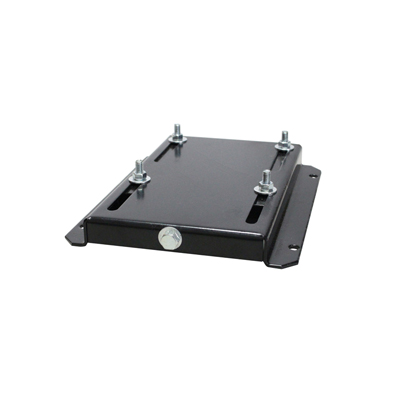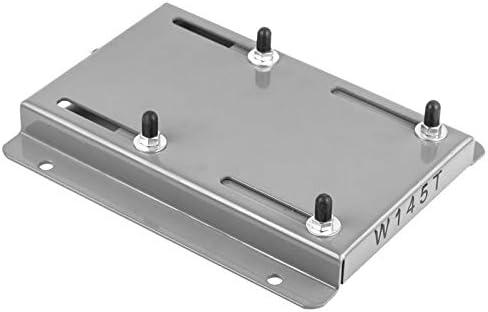Product Description
Product Image
Product Description
| Sheet Metal Stamping Fabrication | |
| Product Name: | Heavy Duty Adjustable Motor Mounting Bases Sheet Metal Bending Assembly Base |
| Material Capacity: | Carbon steel, stainless steel, aluminum plate, brass, copper or galvanized sheet metal etc. |
| Material Thickness: | 0.1-16mm or customized |
| Surface Finishing: | Zinc plated, powder coated, painting, polishing, brushing, chrome plating, anodizing, sandblasting, etc. |
| Process Capability: | Stamping, bending, deep drawing, welding, laser cutting, CNC turning, milling,drilling, etc. |
| Professional level: | Sticking to the strict technical requirements to ensure the strength and accuracy of the product, professional technique negotiation, prompt production, guaranteed quality, 100% inspection, fast & convenient shipping logistics. |
| Samples service: | Available |
| Trade Term: | FOB ZheJiang |
| Payment Term: | T/T |
| Delivery: | Sample:7-15 working days |
| Bulk:20-30 working days (depend on the quantity) | |
| Payment: | Payment<=1000USD, 100% in advance. |
| Payment>=1000USD, 30% T/T + 100% Mold Fees in advance, balance before shipment. | |
Factory show
Testing Equipment
Shipment
FAQ
A: We are a manufacturer (established on May, 2571) and international trading company (established on Aug 1th, 2571) |
A:Yes, we mainly promote customized processing routes (process customization, material customization, surface treatment customization, etc.). According to your samples or drawings, our professional designers will draw 3D data models for you and make samples! |
A: We will prevent beforehand, manage during the event, and guarantee after the event. Confirm with you every details before quoting. After you order, we will reconfirm all the details again. So we can reduce the losses of time and costs. |
| 4. How can I receive a quotation? A: Please send us your product drawings or picture information via email, and we will provide you with a product quotation within 2 working days! |
| 5. How can I get samples? Custom products: We charge 1-3 times the unit price (based on product specifications) Shipping methods are DHL, FedEX, TNT, UPS, EMS or others. You need pay for shipping. Samples will be sent as soon as payment is received! |
| 6. How do I place an order? A: Please try to provide the following information: * Product information: specifications, quantity, delivery requirements *Payment * Shipping information: name, detailed shipping address, phone number, shipping requirements (courier, air or sea). * If there is a cooperative freight forwarder, please provide the contact information of the freight forwarder. * Please send us an official purchase order by email. or we can provide proforma invoices for you. 7. How to send the product to me? |
|
8. Can you arrange the transportation of the goods for me? A: Yes, we can send you by sea, air or courier. |
| 9.What is your preferred payment item? 1) Samples are paid via paypal and T/T is 100% paid. 2) Bulk orders: T/T 30% prepaid, the balance should be paid before shipment. |
| 10. If you want to know more, Please contact me through my business card! |
/* January 22, 2571 19:08:37 */!function(){function s(e,r){var a,o={};try{e&&e.split(“,”).forEach(function(e,t){e&&(a=e.match(/(.*?):(.*)$/))&&1
| Standard: | GB, EN, API650, China GB Code, JIS Code, TEMA, ASME |
|---|---|
| Tolerance: | +/-0.10mm |
| Surface Treatment: | Anodizing |
| Machining Method: | CNC Stamping |
| Material: | Aluminum Plate |
| Application: | Widely |
| Samples: |
US$ 20/Piece
1 Piece(Min.Order) | |
|---|
| Customization: |
Available
|
|
|---|

Are motor bases compatible with different types of motor mounts and couplings?
Motor bases are designed to be compatible with different types of motor mounts and couplings. Here’s a detailed explanation:
1. Motor Mounts: Motor bases typically provide standard mounting options that are compatible with various motor mount configurations. Common motor mount types include:
- Foot Mounts: Motor bases with foot mounts have slots or holes that align with the mounting feet on the motor. These bases allow for secure attachment and proper alignment of the motor.
- Flange Mounts: Some motors have flanges instead of feet for mounting. Motor bases designed for flange-mounted motors have matching flange patterns that ensure proper alignment and secure attachment.
- Face Mounts: In certain applications, motors are mounted directly to a surface using a face mount configuration. Motor bases compatible with face mounts provide the necessary mounting features, such as bolt patterns or mounting brackets, to facilitate this type of installation.
Motor bases are typically available in different configurations to accommodate these various motor mount types. This compatibility ensures that the motor base can securely and correctly mount different motor types, allowing for flexibility and ease of installation.
2. Motor Couplings: Motor bases are not directly involved in the coupling between the motor and driven equipment. The coupling is a separate component that connects the motor shaft to the driven shaft, such as a pump or gearbox. Motor bases do not have specific compatibility requirements with motor couplings.
However, it’s important to consider the space and clearance requirements for the coupling when selecting a motor base. Motor bases should provide adequate space for the coupling and allow for proper alignment between the motor and driven equipment.
Motor bases play a vital role in supporting and aligning the motor, irrespective of the type of motor mount or coupling used. They provide a secure and stable platform for mounting the motor, ensuring proper alignment, minimizing vibrations, and supporting the overall performance of the motor.
When selecting a motor base, it’s essential to consider the motor mount type specified by the motor manufacturer and ensure compatibility with the chosen base. Additionally, considering the space requirements for the motor coupling and its alignment with the driven equipment can help determine the appropriate motor base configuration.
In summary, motor bases are designed to be compatible with different types of motor mounts, including foot mounts, flange mounts, and face mounts. They provide the necessary features and configurations to securely and properly mount the motor. Motor bases are not directly involved in motor coupling, but they should accommodate the space and alignment requirements of the coupling. Considering motor mount compatibility and coupling clearance when selecting a motor base ensures a well-integrated and efficient motor installation.

What role does corrosion resistance play in the selection of motor bases?
Corrosion resistance plays a crucial role in the selection of motor bases. Here’s a detailed explanation:
1. Protection of Motor Base: Motor bases are often exposed to various corrosive agents such as moisture, chemicals, saltwater, or industrial gases. Corrosion-resistant motor bases are designed to withstand these corrosive environments and prevent the deterioration of the base material. By selecting a corrosion-resistant motor base, you can ensure its durability and longevity, reducing the risk of premature failure or structural damage.
2. Preservation of Aesthetic and Functional Appearance: Corrosion can impact the aesthetic appearance of the motor base, causing discoloration, rust, or pitting. However, corrosion resistance helps maintain the visual appeal of the motor base over time. Additionally, corrosion can compromise the functionality of the motor base by weakening its structural integrity or hindering its adjustability features. By choosing a corrosion-resistant motor base, you can preserve both the aesthetic and functional aspects of the base.
3. Protection of Surrounding Equipment: Corrosion can extend beyond the motor base itself and affect other components or equipment in the vicinity. For example, if a corroded motor base transfers rust or contaminants to connected equipment, it can lead to operational issues or premature failure of those components. Opting for a corrosion-resistant motor base helps protect the surrounding equipment and ensures the smooth operation and reliability of the entire system.
4. Improved Maintenance Efficiency: Corrosion-resistant motor bases require less frequent maintenance and repair. They are less prone to degradation, which reduces the need for regular inspections, cleaning, and surface treatments. This not only saves time and effort but also minimizes maintenance costs associated with corrosion-related issues.
5. Environmental Compatibility: Industries or applications that involve exposure to corrosive environments, such as coastal areas, chemical plants, or wastewater treatment facilities, require motor bases that can withstand these conditions. Corrosion-resistant motor bases are designed to meet the specific environmental challenges and provide reliable performance in such demanding settings.
6. Long-Term Cost Savings: Although corrosion-resistant motor bases may have a higher initial cost compared to standard bases, they offer long-term cost savings. By investing in a high-quality corrosion-resistant motor base, you can mitigate the expenses associated with premature replacement, repairs, and downtime caused by corrosion-related issues.
When selecting a motor base, consider the environmental conditions, exposure to corrosive agents, and the expected service life of the motor base. Consult with manufacturers or suppliers to identify corrosion-resistant options that are compatible with the specific application requirements. They can provide guidance on suitable materials, coatings, or finishes that offer optimal corrosion resistance for your motor base.

What role does a motor base play in reducing vibration and noise from motors?
A motor base plays a crucial role in reducing vibration and noise generated by motors. Here’s a detailed explanation:
Electric motors can produce significant vibrations and noise during operation, which can have negative effects on equipment, structures, and human comfort. Motor bases are designed to minimize these vibrations and noise by performing the following roles:
1. Vibration Dampening: Motor bases are constructed using materials and designs that help dampen the vibrations produced by motors. Materials with good vibration-dampening properties, such as steel or cast iron, are commonly used in motor bases. These materials absorb and dissipate vibrations, preventing them from propagating to the supporting structure. By reducing vibrations, motor bases help minimize the transmission of vibrations to surrounding equipment, which can prevent damage, improve performance, and extend the lifespan of connected machinery.
2. Isolation: Some motor bases incorporate isolation features to further reduce vibration transmission. These bases may include elastomeric mounts, springs, or other damping elements that isolate the motor from the mounting surface. These isolating elements absorb and dissipate vibrations, providing an additional layer of protection against vibration transmission. Isolation helps prevent vibrations from being transferred to the supporting structure, reducing the potential for structural damage and minimizing noise generation.
3. Stability and Alignment: Proper alignment and stability of the motor are essential for reducing vibrations. Motor bases provide a secure and stable mounting platform that ensures the motor remains properly aligned during operation. Proper alignment helps reduce vibrations caused by misalignment, unbalanced loads, or belt tension issues. By maintaining stability and alignment, motor bases contribute to smoother motor operation, minimizing vibrations and associated noise.
4. Noise Absorption: In addition to reducing vibrations, motor bases can also help absorb and dampen noise generated by motors. The materials and construction of the base can contribute to noise reduction. For example, motor bases made of sound-absorbing materials or incorporating noise-reducing designs can help mitigate the noise generated by the motor, creating a quieter working environment.
By addressing vibration and noise issues, motor bases contribute to improved equipment performance, reduced maintenance needs, enhanced operator comfort, and increased workplace safety. However, it’s important to note that the effectiveness of a motor base in reducing vibration and noise depends on factors such as the motor size, operating conditions, mounting configuration, and the specific design features of the base.
In summary, motor bases play a vital role in reducing vibration and noise from motors. They dampen vibrations, isolate the motor, provide stability and alignment, and can contribute to noise absorption. By minimizing vibrations and noise, motor bases help protect equipment, structures, and human well-being, ensuring smoother and quieter motor operation.


editor by CX 2024-03-26
by
Leave a Reply